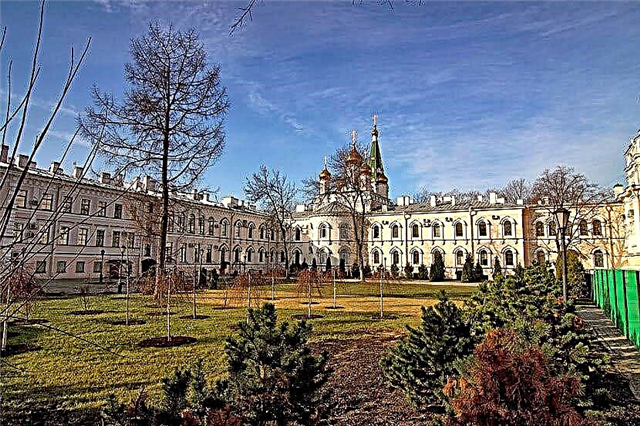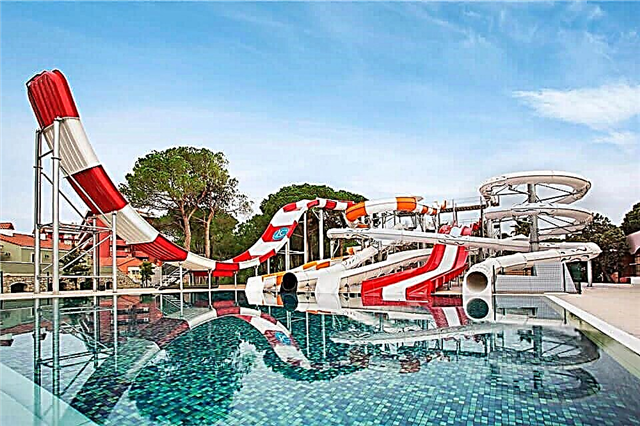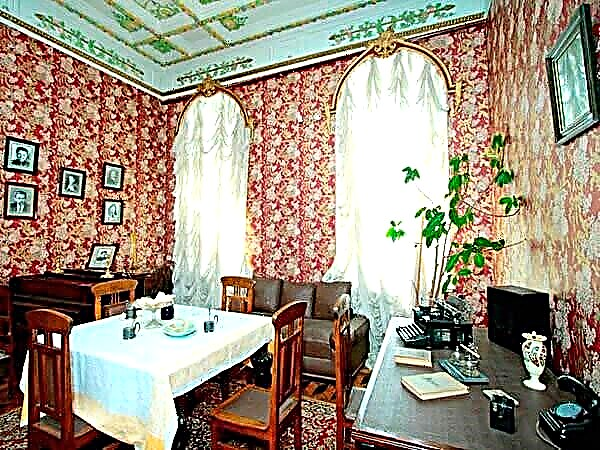Address: Russia, Saint Petersburg, Moskovsky prospect
Foundation date: 1740 year
Main attractions: Resurrection Cathedral, Kazan Church, Church of the Athos Icon of the Mother of God
Shrines: relics of Saint Hilarion
Coordinates: 59 ° 53'55.3 "N 30 ° 19'16.6" E
Federal cultural heritage site of the peoples of the Russian Federation
Content:
One of the two women's monasteries in the city appeared thanks to the daughter of Peter I - Empress Elizabeth Petrovna. The monastery buildings were created by the best architects of their time, but they suffered greatly during the years of the state's struggle with religion. The churches that have been restored are among the most beautiful cathedrals and temples in St. Petersburg.

Resurrection Novodevichy Convent from a bird's eye view
Milestones in history
In the 1740s, a new nunnery was founded on the lands of the Smolny Dvor. At the behest of the Empress, the project of the monastery buildings was prepared by the talented architect Bartolomeo Rastrelli. During this period, Russia participated in the Seven Years War, there was not enough money in the budget, so the construction of the monastery had to be suspended.
In 1845, the nuns and nuns were moved to Vasilievsky Island. The women lived in a small house, did not have their own church, and attended services at the nearby Annunciation Church.
In 1848, by order of Nicholas I, the monastery received a plot of land outside the Moscow outpost. The Russian emperor, together with Metropolitan Nikanor, laid the first stone in the foundation of the new monastery.

View of the Resurrection Cathedral of the Resurrection Novodevichy Convent from the side of Moskovsky Prospect
The area near the Moscow tract was quickly cleared of forest, and the construction of churches, living quarters and outbuildings began here. The work was going fast, so already in 1854 the nuns were able to move from the temporary huts to the new stone building.
Annually 25 thousand rubles were allocated from the treasury for the arrangement of the monastery. The monastery was supported with money by well-known people in Russia, nobles and merchants. One of the main donors was the daughter of Emperor Nicholas I - Olga and Countess Anna Alekseevna Orlova-Chesmenskaya.
The entire life of the Orthodox monastery was led by Abbess Theophania (Gotovtseva). The biography of this extraordinary woman is very interesting. She was born into a noble family and graduated with honors from the Smolny Institute for Noble Maidens.

View of the Resurrection Cathedral of the Resurrection Novodevichy Convent from the Kazan Church
In 1809, the future abbess lost her husband, General Stepan Semenovich Gotovtsev, who was mortally wounded during the battles of the Russian-Swedish war. After 4 years, she buried her only daughter, and a few years later she took monastic vows under the name Theophany.
The abbess with great enthusiasm carried out the work on the creation of the women's monastery. She supervised the construction, helped the sisters to equip the life, found craftsmen and benefactors. Theophania died in her eightieth year of life and found her last refuge in her monastery.
At the beginning of the last century, more than four hundred nuns lived in the monastery. The monastery owned 8 churches, a prosphora, a library, a stable, a vegetable garden, a garden, a stockyard and a poultry house. The nuns worked in the hospital, at the bee-house, in the icon painting, carpet, chasing, shoe and gold embroidery workshops, taught classes in an orphanage for children and a parish school.

View of the domes of the Resurrection Cathedral
With the change of government, the attitude towards the church changed. In 1918, the convent was abolished. To be able to pray, believers and nuns were forced to register a labor community at the temple.
By 1938, not a trace of church life remained. For two decades, the prosperous monastery was completely ruined. The Great Resurrection Cathedral lost its golden domes, and cemetery temples and chapels were dismantled for building materials. Due to alterations, the appearance of the monastery was completely distorted.
In the 1930s, the authorities of Leningrad decided to straighten Moskovsky Prospekt, which was then called International. To lay a new section of the road, the workers blew up the architectural dominant of the monastery complex - the high St. Isidor's bell tower. It is noteworthy that the vacated place remained undeveloped.

View of the Church of the Vatopedi Icon of the Mother of God from Moskovsky Prospekt
In the midst of the anti-religion campaign, more than 90 nuns were arrested and evicted from the city. The remaining buildings were converted for the needs of a regime military enterprise - the Research Institute of Electrical Engineering.
The revival of the ancient monastery began in 1989. First, the old Kazan Church was handed over to the believers, and then - three small wings. In the mid-1990s, they began to revive the monastic way of life.
When the first sisters settled on the territory, the burial place of the first abbess of the monastery, Abbess Theophania, was cleared from under the asphalt layer. In the 2000s, large-scale restoration work was carried out to restore the cathedral and temples.

View of the Church of the Vatopedi Icon of the Mother of God from the courtyard of the monastery
Temples and buildings
The majestic Resurrection Cathedral is considered the pearl of the monastery. The representative temple was erected in the middle of the 19th century according to the drawings of the architect Nikolai Efimovich Efimov. It has two floors and resembles the best cathedrals of Vladimir-Suzdal Rus.
The facades of the building are decorated with paired columns and arcades. Five gilded onion domes rise on faceted drums. There are belfries in four corner drums.
In the austere and restrained cathedral, five thrones have been consecrated. The original interiors have not survived. Everything that is in the temple was recreated in the 2000s. Modern St. Petersburg icon painters have been restoring wall paintings for 7 years, and today the frescoes on the walls and domes occupy more than 6,000 square meters. m.

Kazan Church of the Resurrection Novodevichy Convent
Next to the cathedral is the beautiful Kazan Church, which was built in the image of the Cathedral of Saint Sophia in Constantinople by the architect Vasily Antonovich Kosyakov. The squat five-domed church appeared at the beginning of the last century at the expense of the merchant families Kashintsevs and Panteleevs.
The slender church is decorated with majolica and ornaments, and its portals are made of concrete stucco with bright mosaic inserts. Inside you can see updated wall paintings, the image of Our Lady of Kazan and three carved iconostases.
The tent-roofed church of the Athos Icon of the Mother of God was erected in the 1850s. After the return of the monastery to the believers, the temple was restored and painted. Now it needs a major overhaul of the drum and dome, and therefore is closed for reconstruction. The old temple of the Three Saints is also being restored.

Entrance portal of the Kazan Church
Since 2012, the house church of Seraphim Vyritsky has existed in the abbot building. The murals of the small church reflect the main milestones in the saint's life. All frescoes have a bright azure background.
Another newly built temple is located in one of the monastery buildings. A church in honor of the appearance of the Mother of God to Sergius of Radonezh appeared in 2014. Its iconostasis was painted by young student artists, and the temple image was painted by the nuns themselves.
The monastery houses a small chapel of St. Sergius of Radonezh and St. Nina, Equal to the Apostles - an exact copy of the chapel of the mid-19th century. According to legend, it was here that a neat wooden tower stood, where they collected money for the construction

The courtyard of the Resurrection Novodevichy Convent
Novodevichy cemetery
The monastery necropolis appeared soon after the founding of the monastery.It was one of the most prestigious and expensive cemeteries in the capital of the empire, and prominent figures of the Russian state, noblemen and wealthy merchants were buried there. Among the first to be buried in the monastery cemetery was the author of the architectural project of the monastery - N. Ye. Efimov.
In the post-revolutionary years, most of the graves were destroyed. In 1995, the historic cemetery received the status of a federal monument. Today, you can see more than 100 burials and tombstones on it.

Novodevichy cemetery
Useful information for tourists
The Orthodox monastery has been restored and is open to believers and tourists. The monastery has a sewing workshop, an almshouse and a church shop, a Sunday school and an orphanage. The monastery owns the Holy Trinity Skete in the village of Zhuki, Pskov region and the temple of the Origin of the Honorable Trees of the Life-Giving Cross of the Lord in the village of Lisino-Korpus, which is located not far from St. Petersburg.
Church services are held every day - from Tuesday to Friday at 7:00 and 17:00, on Saturdays - at 9:00 and 16:00, on Sundays - at 7:00, 9:40 and 17:00, and on Mondays at 9:00 and 17:00.

Cross-fountain on the territory of the monastery
How to get there
The monastery is located 800 meters from the metro station "Moskovskie Vorota", at Moskovsky Prospekt, 100. Near the entrance to the monastery there is a bus, trolleybus and route taxi stop "Tram Park No. 1".











